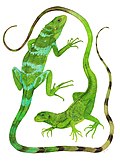| Ctenosaura quinquecarinata | |
|---|---|

| |
| Conservation status | |
 Data Deficient (IUCN 3.1) | |
| CITES Appendix II (CITES) | |
| Scientific classification | |
| Domain: | Eukaryota |
| Kingdom: | Animalia |
| Phylum: | Chordata |
| Class: | Reptilia |
| Order: | Squamata |
| Suborder: | Iguania |
| Family: | Iguanidae |
| Genus: | Ctenosaura |
| Species: | C. quinquecarinata |
| Binomial name | |
| Ctenosaura quinquecarinata (Gray, 1842) | |
| Synonyms | |
Ctenosaura quinquecarinata, commonly known as the Oaxacan spinytail iguana or the five-keeled spiny-tailed iguana is a species of lizard in the family Iguanidae native to Central America.
Geographic range
It is found in Costa Rica and Nicaragua. Other sources list it also from Mexico and El Salvador.
Habitat
Its natural habitat is tropical dry forests.
Conservation status
It is threatened in its native range by habitat loss.
Taxonomy and etymology
Ctenosaura quinquecarinata was first described by zoologist John Edward Gray in 1842 as Cyclura quinquecarinata; 32 years later it was redesignated by Marie Firmin Bocourt as Ctenosaura quinquecarinata. The generic name, Ctenosaura, is derived from two Greek words: ctenos (Κτενός), meaning "comb" (referring to the comblike spines on the lizard's back and tail), and saura (σαύρα), meaning "lizard". Its specific name quinquecarinata is a combination of two Latin words: quinque meaning "five" and carinata meaning "keeled" and refers to the five rows of scales on the animal's tail.
Description
The tail on this species is heavily armored with five rings of spines forming longitudinal ridges. Males of the species grow to a length of 35 centimeters (14 in) whereas females attain 18.5 centimeters (7.3 in). Like most Ctenosaura the iguanas are born a bright green color fading to brown as the animal ages. The females tend to turn a uniform drab brown in color, and males develop tones of black, blue and yellow on their bodies and heads over the brown background.
Threats
Total population size is not known, but it is estimated that there may be fewer than 2,500 mature individuals. It is threatened by habitat loss through deforestation, overcollection through an unregulated exploitation for the pet trade, and it is even hunted by humans as a food item.
References
- ^ Reynoso, V.H.; Ubeda, M.; Vázquez-Cruz, M.; Rivera-Arroyo, R.C.; Malone, C.L.; Grant, T.D. (2020). "Ctenosaura quinquecarinata". IUCN Red List of Threatened Species. 2020: e.T44193A2993977. doi:10.2305/IUCN.UK.2020-2.RLTS.T44193A2993977.en. Retrieved 16 November 2021.
- "Appendices | CITES". cites.org. Retrieved 14 January 2022.
- "Ctenosaura quinquecarinata". Integrated Taxonomic Information System. Retrieved 2 January 2008.
- ^ Ctenosaura quinquecarinata at the Reptarium.cz Reptile Database. Accessed 13 November 2015.
- Malfatti, Mark (2007). "A look at the genus Ctenosaura: meet the world's fastest lizard and its kin". Reptiles Magazine. 15 (11): 64–73.
Further reading
- Gray, J.E. 1842. Description of some new species of Reptiles, chiefly from the British Museum collection. Zoological Miscellany 57–59. (Cyclura quinquecarinata, p. 59.)
| Iguanidae | ||||||||||||||||||||||||
|---|---|---|---|---|---|---|---|---|---|---|---|---|---|---|---|---|---|---|---|---|---|---|---|---|
| ||||||||||||||||||||||||
| Taxon identifiers | |
|---|---|
| Ctenosaura quinquecarinata |
|
